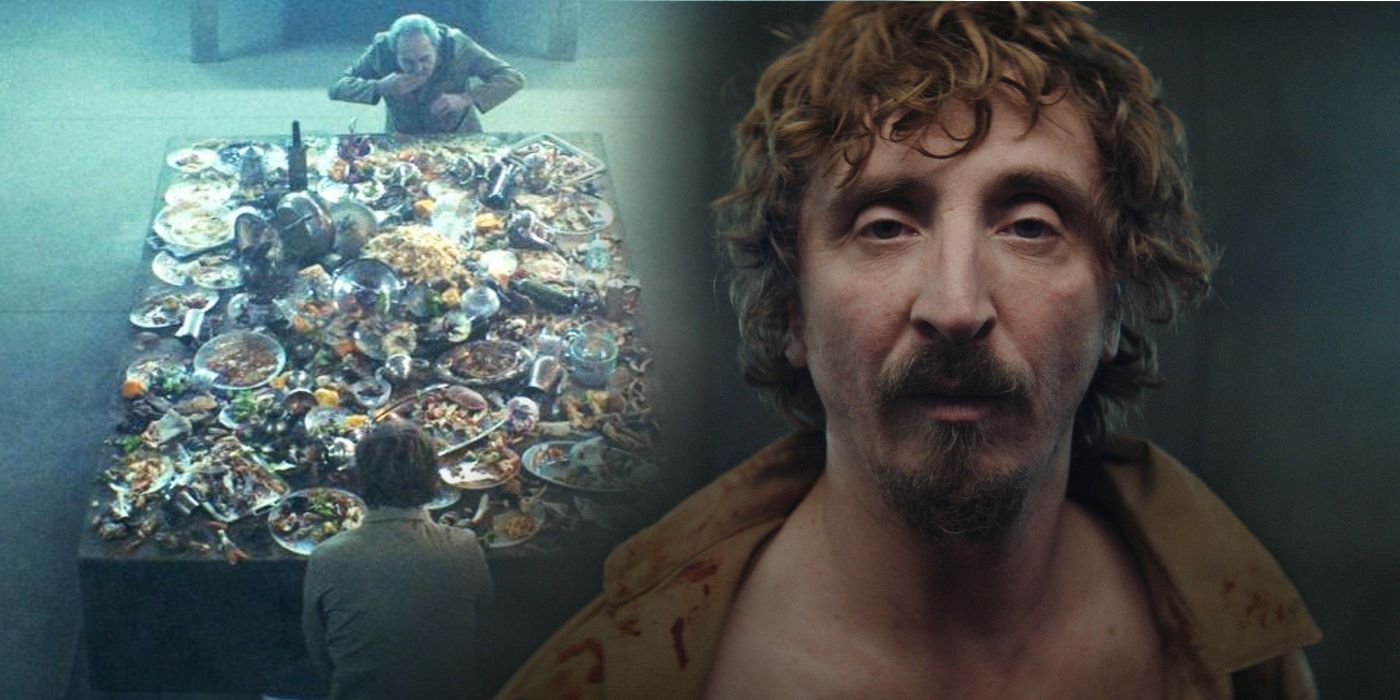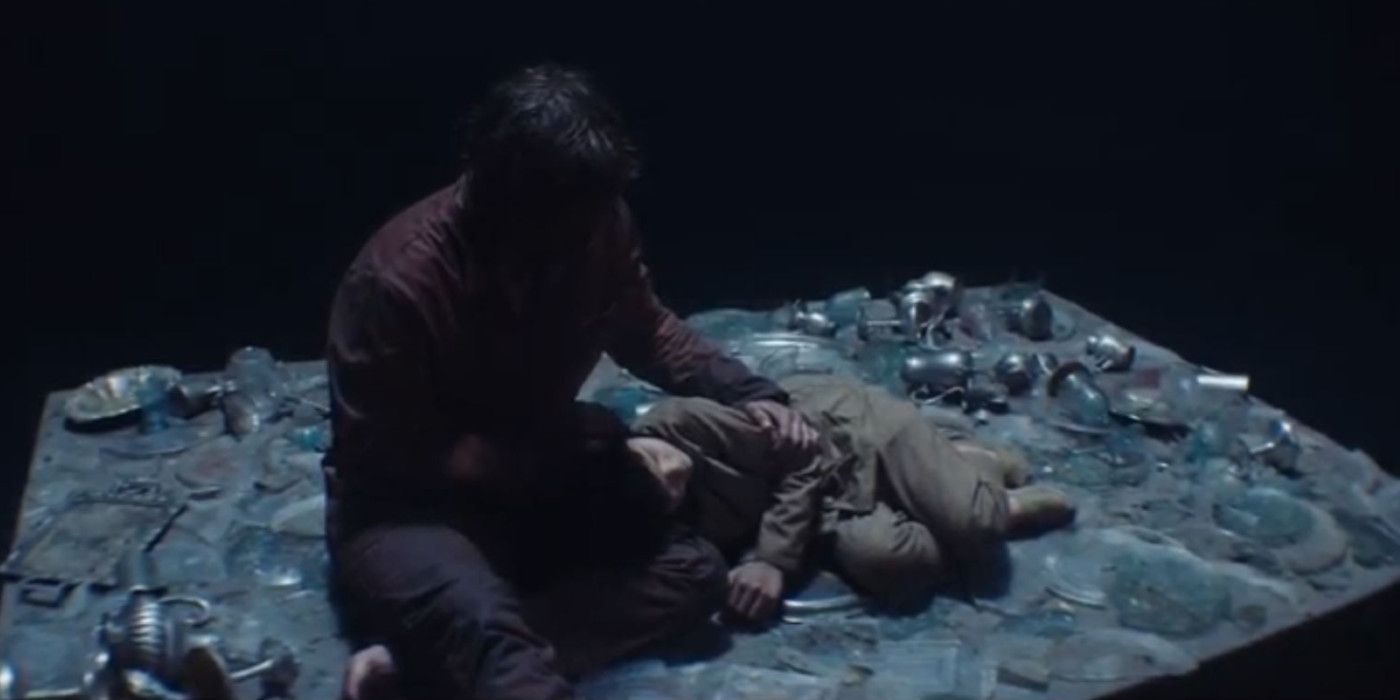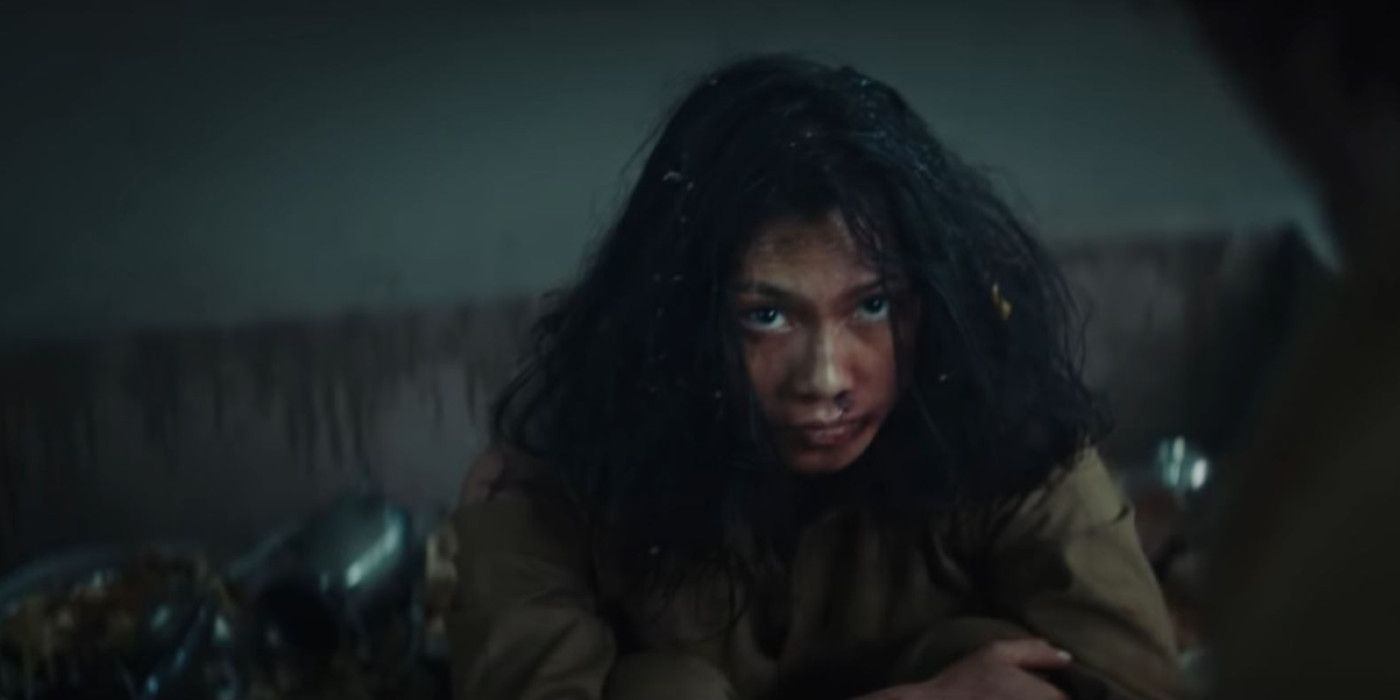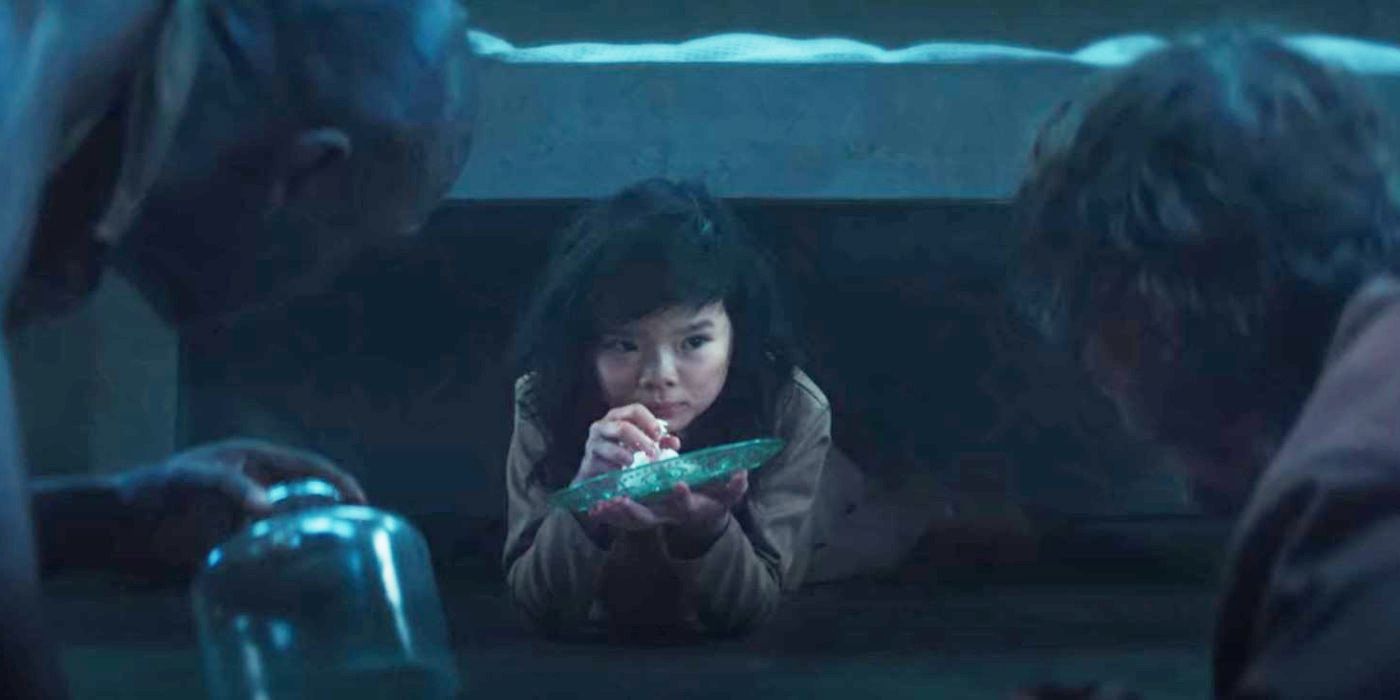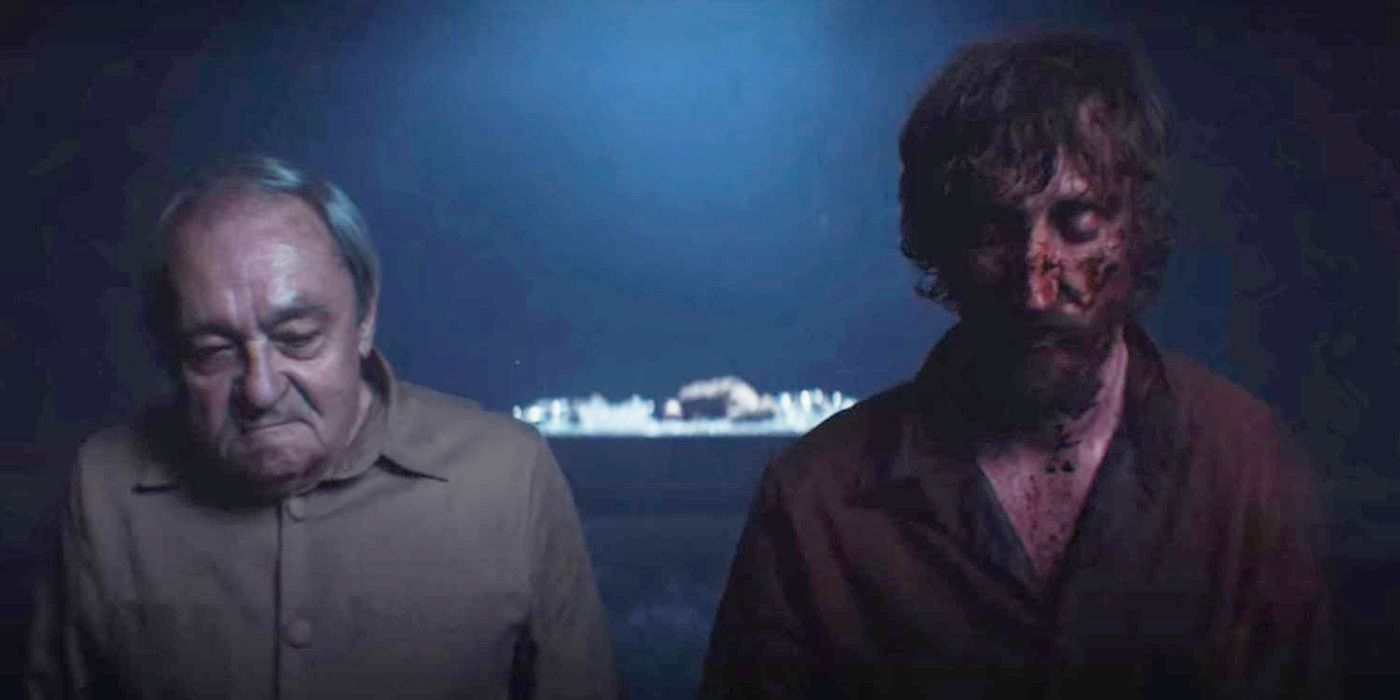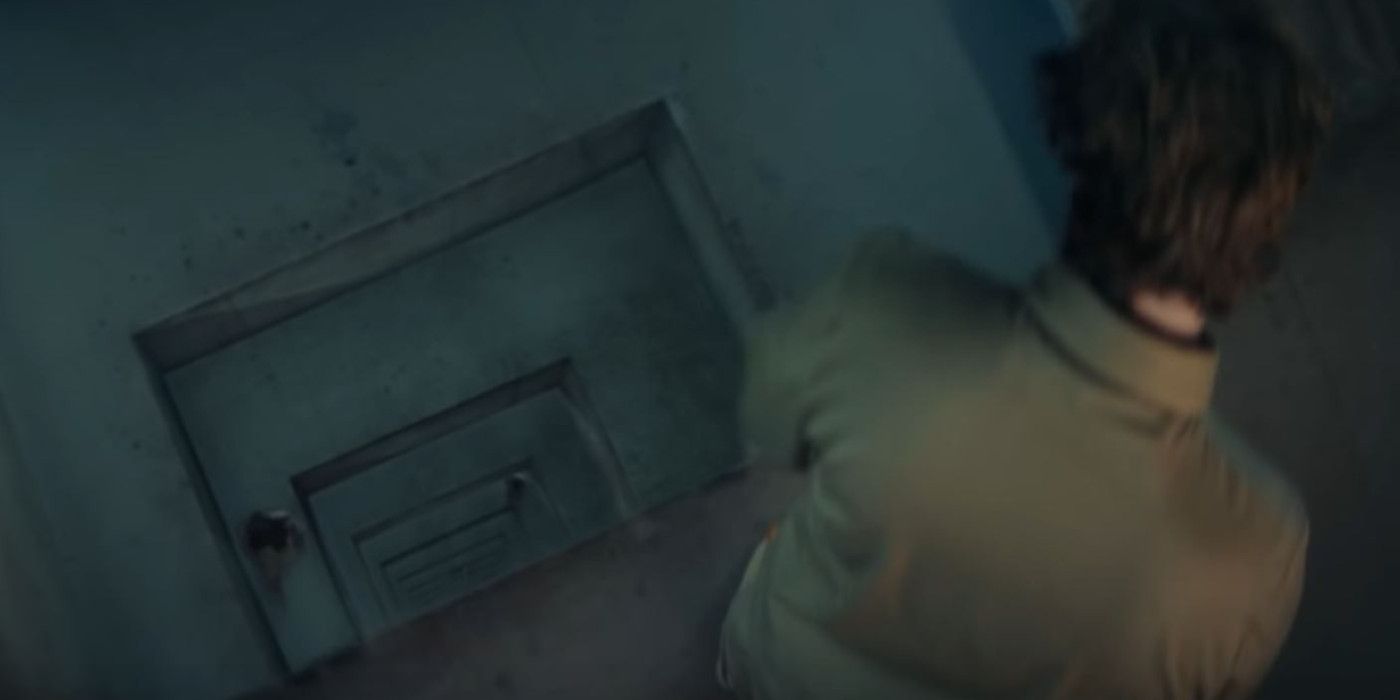Netflix's The Platform left a lot of questions up in the air. The Platform's ending was a damning condemnation of capitalist greed, while arguing that for humankind to thrive, the world needs to move towards a more egalitarian distribution of wealth. The Platform has already been hailed as a Spanish-language equivalent to the works of Bong Joon-Ho such as Snowpiercer and the Oscar-winning Parasite.
Directed by Galder Gaztelu-Urrutia, The Platform follows the journey of Goreng (Iván Massagué) after he volunteered for a stay in "a Vertical Self-Management Center." The social experiment involved food being delivered through a platform, with those at the top getting first dibs as the platform moves down the tower. The Netflix horror movie examines ideas of greed and accountability: the premise — the people in the facility competing for food, with those on the top floors having more than enough and those on the bottom starving — is a clear analogy for capitalism.
Though he ultimately escaped, Goreng found himself on a grotesque journey to not only survive but fix the broken system as desperation, hunger, and even madness began to set in. Goreng is forced to travel deeper and deeper into The Pit, with the story increasingly becoming metaphorical and ambiguous. As a result, there are still many big, thought-provoking questions for audiences to ponder long after The Platform's highly symbolic ending.
What Happened To The Child After She Reached Level 0?
As part of his mission to change the system in Netflix's The Platform, Goreng ultimately teamed with Baharat (Emilio Buale Coka). Following a failed attempt to climb to the uppermost levels, Goreng suggested that they instead needed to journey down rather than up. Deciding to travel down with the platform, they armed themselves and resolved to force the residents of each level to take only a fair share. Along the way, they were also advised that they needed to send a message to Level 0 in the form of an untouched panna cotta dessert. Both endeavors proved increasingly difficult - with hunger and desperation fueling ever more violent encounters as the film's ending drew nearer and they ventured lower into The Pit.
The starkest encounter in The Platform (which, due to its powerful and disturbing social commentary and general themes, easily made it one of Netflix's best horror movies in 2020) occurred when Goreng and Baharat, exhausted and clinging to life, arrived on Level 333. There, they met a young girl living completely alone. Opting to let her eat the coveted panna cotta, Goreng realized that she was the message of hope for the future and a symbol that the horrors permeating The Pit need to be addressed. As such, she was what needed to be sent back to Level 0. Helping her onto the platform, the girl drifted to sleep as Goreng succumbed to his wounds and opted to remain in the bowels of The Pit with a vision of Trimigasi. The platform immediately began its rapid ascent back to the top...only for credits to roll and the idea of what happened next to remain as a notably big and unanswered question.
That was clearly Urrutia's intention. In an interview with Digital Spy, the director revealed that they actually shot an alternate ending for The Platform that depicted her arrival on Level 0. However, the film's producers decided to cut it in favor of something ambiguous. This actually works for the film, with The Platform leaning more into metaphors and symbolism in its final act. Unfortunately, it also means that what fate befell the child - and The Pit itself - is left entirely to the imagination. As such, it's entirely dependent on whether those watching learn towards hope or something wholly more pessimistic when answering these questions for themselves.
Why Did Miharu Kill The Dog?
Another of Goreng's ill-fated companions in The Platform was Imoguiri (Antonia San Juan) on Level 33. With residents allowed to bring one thing with them into The Pit, Imoguiri chose her beloved dog, Ramesses II. Unfortunately, after helping Miharu (Alexandra Masangkay) heal from wounds afflicted during her latest journey down through the levels, Goreng awoke to find that she had killed the dog. But, the question is, why? On the surface, it appeared as though Miharu had done so merely for sustenance. After all, it was clear that she, like many other major and minor characters in the 2020 horror movie, had been changed by The Pit. One result of her time imprisoned in The Platform was that she had grown to rely on eating the flesh of fresh kills to survive. As such, it's understandable that Miharu may have just gotten a taste for it. Equally, given that Imoguiri used to be the one who interviewed people for admittance into the hellish facility, Miharu could have killed the dog out of revenge.
Then again, The Platform repeatedly implied that Miharu wasn't quite as crazed and mindless a killer as suggested by others. This could especially be true of the information imparted by Imoguiri. Despite her noble intentions upon arriving in The Pit, wanting to help fix the system she had actively contributed for years, Imoguiri was understandably distraught by the murder of her beloved pet. As such, coupled with later revelations, a lot of what is offered about Miharu in this social commentary-fueled movie can be taken with a grain of salt. The revelation of the little girl on Level 333 added fresh dimensions to Miharu's actions. Though she did kill to eat, it could also be construed that she also killed to provide the little girl things to eat. Equally, the killing of the dog also made it that there was one less mouth to feed between Level 0 and Level 333, meaning that Miharu might have just been thinning the herd, as it were. Whatever the case, a definitive answer was never offered before The Platform's ending, but instead left as an open-ended question to be decided on with one's own interpretation.
Where Did The Child Come From?
The appearance of the little girl on Level 333 is yet another big question that, on the surface, seemed to receive an answer. Early on during The Platform, it's established that Miharu's mission each day is entwined with searching for or otherwise protecting a child. The existence of a child is proven to be true, as Goreng and Baharat discovered. Given that the young girl in this Netflix horror movie is similarly Asian, the implication is that it's clearly Mirahu's own. Equally, the girl is dressed in the same outfit as the other residents, albeit in her size. While other residents are often switched levels, she seemed to remain a permanent resident of Level 333. That would imply that at least some within The Administration are aware of her presence. As such, it seems pretty cut and dry. However, it's thrown into disarray (and subsequently forced to be questioned by viewers) due to the inconsistent statements issued by numerous Platform characters.
Though Goreng initially takes Miharu's story at its word, it's countered by Imoguiri - who states that nobody under sixteen is allowed permitted within The Pit. Equally, as somebody who worked for the company that oversees the facility, she states that Miharu, like Goreng before The Platform's events, voluntarily signed up. With a desire to procure means of becoming an actress, Imoguiri says that Miharu has been in The Pit no more than a year ago and had no child when she entered. On the other hand, Imoguiri's initially noble nature in Gaztelu-Urrutia's sci-fi horror movie ends up going out the window once her dog is killed. She almost immediately began referring to Miharu with racial epithets and could merely have been trying to sway Goreng against her. She could have been lying about whether Miharu was pregnant or had a child with her when she entered. Similarly, she could have been lying about the length of Miharu's stay - thus opening up the possibility that the child was conceived on-site (be it consensually or otherwise).
Then again, the child might have entered The Pit another way even before Miharu arrived and Imoguiri merely not know about it. She seemed to genuinely believe that there were only 200 levels before her tragically memorable Platform death. It was when she and Goreng were transferred to Level 202 and would have been able to see many more levels beneath, after all, that Imoguiri opted to kill herself. Whatever the case, the big question behind how the child came to be in The Pit prior to the social commentary-infused film's timeline was never definitively conveyed. It generally comes down to which character the audience chooses to believe by the project's ending. This level of ambiguity was, again, part of Urrutia's design with The Platform. In a separate interview with Collider, the director added fuel to the fire of her uncertain origin by stating, "I know this, but I'm not going to reveal it."
How Much Of The Ending Was A Hallucination?
The Platform never leaned more into its metaphorical nature than when Goreng succumbed to foreboding dreams and hallucinatory visions. The last of these came when Goreng prepared to travel up to Level 0. As the girl drifted off to sleep, Goreng was visited by a ghostly vision of Trimigasi. With his former cellmate declaring that "the message needs no bearer," Goreng relinquished his place on the platform and strolled into the shadows of an expansive void. It seemed as though this was Goreng accepting his fate and preparing to give in to the wounds he had sustained throughout the intensely scary and violent Netflix movie. However, there is actually enough to suggest he might already be dead by The Platform's ending.
Though he had been visited by a specter of Trimigasi before, this instance had very much the feel of somebody's spirit separating from their body. In the same Digital Spy interview, Urrutia actually confirmed this to be the case. "To me, that lowest level doesn't exist," he said. "Goreng is dead before he arrives, and that's just his interpretation of what he needs to do." Unfortunately, that, in itself, provokes more big and unanswered questions. Though he was clear how Goreng sustained his injuries and just how fatal they were, it's unclear when exactly Goreng officially died.
It's plausible that, like Trimigasi, the little girl herself was a figment of his imagination designed to make his journey in The Platform something other than a futile one. The aforementioned version of the horror movie's ending scene, showing what transpired next, would've definitively clarified things, which is likely why it was cut. As such, like the majority of Netflix's The Platform, the conclusion of Goreng's journey will merely remain the subject of fierce debate. Fans can be content in the knowledge that Goreng's story at least had a definitive ending, however, whatever the case may be.
Why Are There 333 Floors On The Platform?
As previously discussed, The Platform is layered in darkly ethereal symbolism and allegorical, though sometimes purposely ambiguous, storytelling. There's a great deal of thought condensed into the project, right up until its very ending at only 94 minutes. And much of it seems to touch upon themes like human nature, desperation, survival, and social classes/capitalistic society. However, anyone who's watched The Platform also knows that the well-done, yet disturbing scene-littered, horror movie is rife with religious symbolism. Belief in God is referenced within some of the dialogue, there are many parallels to Christian communion, and the Christ-like Goreng is even repeatedly referred to as the Vertical Self-Management Center's "messiah." These religious themes also tie in with another big, lingering question after The Platform's ending: why, exactly, are there 333 floors in the building?
Of course, this connects to the conveyed notion of lower levels (and what they're representing, based on interpretation) being closer to Hell. Whereas, on the other hand, The Administration exist as God-like, yet cruel, overseers above all of the levels. Signal Horizon smartly theorized about the specific number of floors' use in the dystopian, sci-fi-rooted horror movie, "The dark pit is a clear visual representation of Hell with 333 levels in between. 333 is half of the number of the beast 666." Other fans of The Platform have voiced similar takes online, also pointing out that having two roommates on each of the center's 333 levels also adds up to the Satanically-associated number "666." This only seems to amplify the already-heavily used religious symbolism in the film, as well as connect the correlation between Heaven or Hell and the level one exists on, whether that's in society or in the sadistic prison in The Platform.

